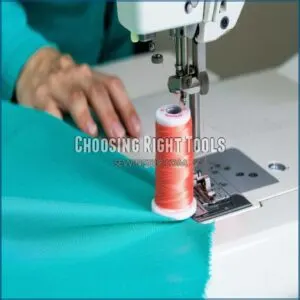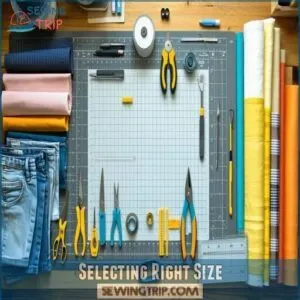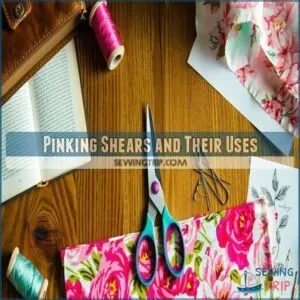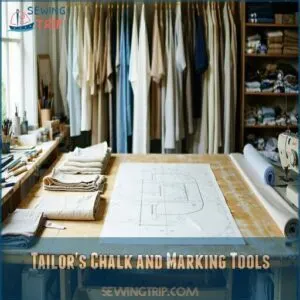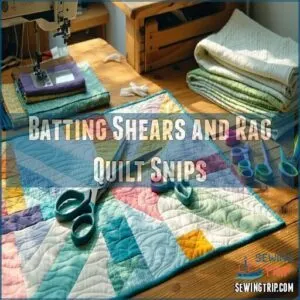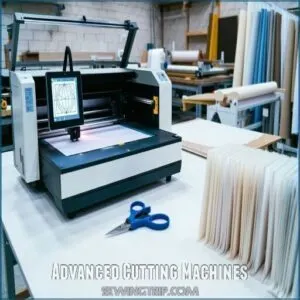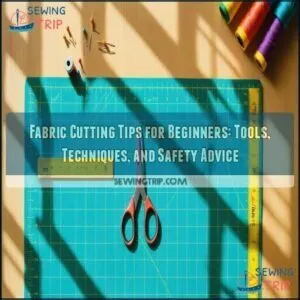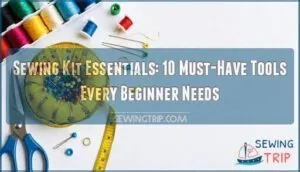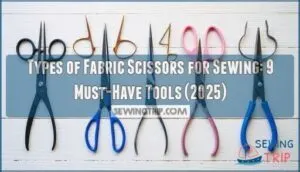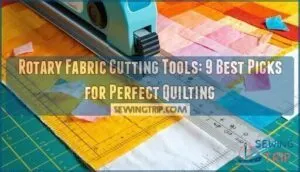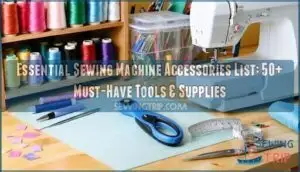This site is supported by our readers. We may earn a commission, at no cost to you, if you purchase through links.
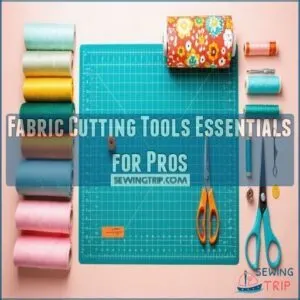 You’ll need the right fabric cutting tools essentials to get the job done.
You’ll need the right fabric cutting tools essentials to get the job done.
Invest in a rotary cutter, cutting mat, and acrylic rulers for accurate cuts. Don’t forget sharp fabric scissors and shears, like sewing scissors or quilting shears.
Choosing the right blade size, like a 45mm rotary cutter blade, is important. With these tools, you’ll be cutting like a pro in no time.
Now, let’s explore how to use them to achieve professional results and discover more tips to take your fabric cutting skills to the next level.
Table Of Contents
Key Takeaways
- You’ll need to invest in quality fabric cutting tools, like rotary cutters and sharp fabric scissors, to get the job done efficiently and accurately.
- Choosing the right blade size, like a 45mm rotary cutter blade, is crucial for achieving professional-looking results, and you should consider the type of fabric you’re working with.
- To cut fabric like a pro, you’ll want to use the right techniques, including preparing your fabric by ironing it, using a cutting mat, and pairing rulers with rotary cutters for straight edges.
- You should also prioritize tool maintenance, such as sharpening your blades regularly, to ensure they remain effective and don’t damage your fabric, and store them properly to prevent rust and deterioration.
Choosing Right Tools
You’re about to learn how to choose the right tools for your fabric cutting needs.
By selecting the correct rotary cutters, fabric scissors, and cutting mats, you’ll be able to make precise cuts and achieve professional-looking results in your projects.
Rotary Cutters and Accessories
You’ll master rotary cutters with the right accessories, including rotary blades, cutting mats, and quilting rulers, ensuring precise cuts and safety precautions.
While handle ergonomics and blade sharpening enhance your experience with rotary cutters and cutting mats.
For efficient fabric cutting, consider using a rotary cutter set to achieve professional results with the right accessories.
Fabric Scissors and Shears
Fabric scissors and shears are your go-to for precision. From sewing scissors to dressmaking shears, sharp blades guarantee cutting accuracy, while handle ergonomics reduce fatigue.
Quilting shears and fabric shears excel at slicing through layers cleanly. Prioritize scissor maintenance and blade sharpening for longevity.
Micro-serrated blades enhance fabric grip, preventing slips. Invest in quality tools for effortless, professional results.
Proper sewing tool selection is essential for achieving desired outcomes.
Cutting Mats and Tools
A cutting mat is your fabric protector, keeping surfaces safe and cuts precise.
Pair it with grid rulers and rotary guides for flawless results. Self-healing mats are perfect for repeated use.
Larger mats handle big projects with ease, while smaller ones are portable.
Here’s your toolkit:
- Cutting mats
- Grid rulers
- Rotary guides
- Fabric scissors
- Cutting aids
Cutting Techniques Essentials
You’ve got the right tools—now let’s focus on fabric cutting techniques to get those clean, precise results.
Start with fabric preparation: always iron your material to remove wrinkles that could throw off your lines.
Use cutting tools like rotary cutters or fabric scissors on a stable surface, preferably a cutting mat, to avoid cutting errors and protect your workspace.
Precision techniques matter—pair rulers with rotary cutters for straight edges or precision cutters for intricate designs.
Keep blade maintenance in mind; a dull blade can snag fabric and ruin your project.
Cutting safety is just as important—use guards on rotary cutters and cut away from your body.
Understanding fabric grain importance is essential for achieving professional-looking results.
With these steps, you’ll cut like a pro every time!
Selecting Right Size
Choosing the right size for your cutting tools can make or break your project’s precision.
From blade sizes to tool dimensions, matching them to your fabric and task guarantees smoother, cleaner cuts every time.
Measuring Fabric for Accurate Cuts
Accurate fabric measurement is the backbone of clean cuts.
Use cutting mats with grid systems and measuring rulers to align edges perfectly. Precision marking tools, like tailor’s chalk, help map out patterns.
Pair rulers with cutting guides for straight lines. Always double-check measurements before cutting—nothing’s worse than realizing your fabric’s too short after the first snip, and accurate fabric measurement is crucial to avoid this. Precision marking tools and cutting guides are essential for achieving professional results.
Choosing Correct Blade Size
Choosing the right blade size boosts cutting efficiency.
Rotary cutters often feature 18mm to 60mm blades; 45mm is the go-to for versatility.
Smaller blades handle curves, while larger ones tackle straight cuts and thick fabrics.
Sharpness factors and durable blade materials, like stainless steel, guarantee precision.
Proper blade selection in your fabric cutting tools makes sewing smoother and more accurate. Understanding blade size rules is key to achieving ideal performance.
Understanding Fabric Types and Tools
Understanding fabric types is key to mastering cutting tools.
Different fabrics—like stretchy knits or slippery silks—pose unique challenges. Pay attention to grain direction for clean cuts.
Use fabric scissors for precision or rotary cutters for speed. For smooth and efficient cutting, explore ergonomic rotary cutter options.
Match tools to fabric properties; for instance, heavy-duty scissors handle thick materials, while pinking shears prevent fraying. Proper fabric manipulation results in accuracy.
Specialized Cutting Tools
When your project calls for more than basic scissors, specialized cutting tools step in to handle unique tasks with precision.
From pinking shears to tailor’s chalk, these tools guarantee clean edges, accurate markings, and professional results.
Pinking Shears and Their Uses
Pinking shears are essential fabric cutting tools for seam finishing and fraying prevention.
Their zigzag blades create decorative edges while working well on various fabric types. Perfect for pinking techniques, they’re ideal for sewing scissors enthusiasts tackling curves or notches.
Unlike standard fabric shears, pinking shears combine functionality and flair, making them a must-have in your cutting tools arsenal.
To achieve professional results, understanding how to use pinking shears is important for any sewing project.
Tailor’s Chalk and Marking Tools
Tailor’s chalk and marking tools let you map out your fabric plans like a pro.
Whether you’re using classic tailors chalk, chalk pencils, or fabric markers, precision marking is key.
Here’s how:
- Use tailors chalk for temporary lines.
- Try chalk pencils for detailed work.
- Fabric markers offer washable options.
- Tracing wheels help transfer patterns accurately.
Understanding proper tailors chalk techniques is essential for achieving professional results.
Batting Shears and Rag Quilt Snips
Batting shears are your go-to for cutting thick batting layers, offering clean, precise cuts without strain.
Pair them with rag quilt snip scissors to create frayed edges for that cozy, textured quilt finish.
Keep scissors sharpness in check for smooth snip techniques.
Use a rotary cutter for straight cuts, but rely on fabric shears for detailed Rag Quilt Tips and edge perfection.
Advanced Cutting Machines
When you’re ready to take fabric cutting to the next level, advanced cutting machines offer unmatched precision and efficiency.
From electric scissors to laser and computer-controlled tools, these machines handle intricate designs and heavy-duty tasks with ease.
Electric Fabric Scissors and Machines
Electric fabric scissors and machines simplify cutting tasks with precision and speed.
Always prioritize machine safety and proper fabric handling to maintain performance.
Here’s why they’re a game-changer:
- Cutting Speed: Slice through layers effortlessly.
- Motor Efficiency: Handles heavy-duty tasks.
- Blade Maintenance: Sharp blades guarantee accuracy.
- Versatility: Works on fabric, leather, and more.
- Ergonomics: Reduces hand fatigue, unlike sewing scissors.
When selecting electric scissors, consider the importance of proper electric scissors maintenance for peak performance.
Computer-Controlled Cutting Tools
Computer-controlled fabric cutting machines, like CNC machines and digital cutters, revolutionize precision.
These automated tools handle intricate designs effortlessly, saving time and reducing errors. Robotic cutters and die cutting systems provide consistent results, perfect for large-scale projects.
Digital interfaces let you customize patterns easily. Whether you’re crafting or manufacturing, these tools give you control and efficiency, making complex cuts a breeze.
Laser and Water Jet Cutting Machines
Laser cutting and water jet machines take fabric cutting to the next level.
They’re precise, fast, and handle intricate designs with ease.
Here’s why they’re worth considering:
- L Cutting Machines: Perfect for delicate fabrics, offering clean edges and precision control.
- Water Jet Cutting Machines: Cut thicker fabrics effortlessly without heat damage.
- Machine Safety: Protective features guarantee safe operation while tackling industrial cutting tasks.
Ultrasonic and Plasma Cutting Machines
Following laser and water jet tools, ultrasonic cutting machines bring unmatched fabric precision.
Using high-frequency vibrations, they slice cleanly through woven or synthetic materials without fraying.
Plasma torch cutting machines, on the other hand, excel at cutting fabrics reinforced with metal fibers.
Both automated cutting machines guarantee cutting efficiency, but always prioritize machine safety when working with these advanced fabric cut tools.
Frequently Asked Questions (FAQs)
What tools do you need to cut fabric?
You’ll need fabric scissors for detailed work, rotary cutters with self-healing mats for straight lines, and a seam ripper for mistakes. Don’t forget rulers and tailor’s chalk for marking measurements.
What is required for the cutting fabric?
You’ll want sharp fabric scissors, a rotary cutter with mat, and a reliable measuring tool.
Don’t forget marking tools like tailor’s chalk.
For precision work, add embroidery scissors and pinking shears.
What tool is usually used for cutting fabric?
You’ll find fabric scissors and rotary cutters are your go-to tools.
Fabric scissors excel at detailed work, while rotary cutters with their circular blades give you clean, precise cuts for larger projects, and rotary cutters are especially useful in this context.
How to cut fabric for beginners?
Picture your fabric laid flat, crisp and ready.
You’ll want sharp fabric scissors for intricate cuts, while rotary cutters with mats work best for straight lines.
Always pre-wash and iron first.
How often should cutting tools be professionally sharpened?
You’ll typically need professional sharpening once or twice yearly for fabric scissors and rotary cutters with regular use. However, heavy users might require quarterly maintenance to maintain clean, precise cuts.
Can fabric cutting tools be used on paper?
You shouldn’t use your fabric scissors on paper as it dulls the blades.
However, rotary cutters can handle both materials, though you’ll need to change blades more frequently when switching between materials.
What causes blades to rust and deteriorate?
Moisture meets metal, and trouble begins.
Your blades rust when exposed to humidity, water droplets, acids in fingerprints, and salt.
Store them dry and clean to prevent deterioration and extend their life.
Should cutting tools be stored vertically or horizontally?
Store cutting tools horizontally in protective sheaths to prevent blade damage.
You’ll find vertical storage works for scissors with handles hanging down.
Whatever position you choose, don’t let blades touch other tools, as this can cause blade damage.
Conclusion
Ultimately, your fabric cutting tools essentials are the backbone of successful sewing projects.
You’ll save time and frustration by investing in quality rotary cutters, durable mats, and precision rulers.
Don’t hesitate to upgrade your toolkit as your skills advance, whether you’re quilting, garment-making, or crafting, the right cutting implements will elevate your work from amateur to professional.
Remember, you’re only as good as your tools—choose wisely and maintain them properly.
- https://textilementor.com/fabric-cutting-methods-essential-guide-beginners/
- https://threadsmonthly.com/sewing-tools-cutting/
- https://www.goldstartool.com/blog/the-best-cutting-tools-for-sewing.htm
- https://thesewingloftblog.com/cutting-tools-for-sewing/
- https://www.suntech-machine.com/events/4-types-of-fabric-cutting-tools-478.html

